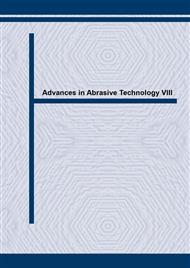[1]
M.C. Shaw: Principles of abrasive processing, Oxford Science Publications, (1996).
Google Scholar
[2]
S. Malkin: Grinding technology: theory and applications of machining with abrasives, Ellis Horwood, Chichester, (1989).
Google Scholar
[3]
A.A. Torrance, J.A. Badger: The relation between the traverse dressing of vitrified grinding wheels and their performance, International Journal of Machine Tool Manufacture Design and Research Vol. 40 (2000), pp.1787-1811.
DOI: 10.1016/s0890-6955(00)00015-8
Google Scholar
[4]
S. Kalpakjian, S.R. Schmid: Manufacturing processes for engineering materials, Prentice Hall, New Jersey, (2003).
Google Scholar
[5]
C. Andrew, T.D. Howes, T.R.A. Pearce: Creep feed grinding (1985). Partition ratio.
Google Scholar
[6]
00 8. 00 10. 00 12. 00 14. 00 16. 00 18. 00 20. 00 22. 00 Depth of cut (microns) R Liquid coolant Air + water/soap mist (5%) Air + water/soap mist (15%) Air + water/soap mist (25%) Specific energy of grinding.
DOI: 10.7717/peerj.10041/table-1
Google Scholar
[35]
00 6 8 10 12 14 16 18 20 22 Depth of cut (microns) Specific energy (J/mm 3) Liquid coolant Air + w ater/soap mist (5%) Air + w ater/soap mist (15%) Air + w ater/soap mist (25%) Linear (Air + w ater/soap mist (25%) Linear (Air + w ater/soap mist (15%) Linear (Air + w ater/soap mist (5%) Linear (Liquid coolant)[6] S. Paul, A.B. Chattopadhyay: Effects of cryogenic cooling by liquid nitrogen jet on forces, temperature and surface residual stresses in grinding steels, Cryogenics Vol. 35 (1995).
DOI: 10.4028/www.scientific.net/kem.291-292.239
Google Scholar
[7]
S. Shaji, V. Radhakrishnan: An investigation on surface grinding using graphite as lubricant, International Journal of Machine Tools & Manufacture, Vol. 42, (2002) pp.733-740.
DOI: 10.1016/s0890-6955(01)00158-4
Google Scholar
[8]
M.C. Shaw: Interrupted grinding principle, Instn Engrs (India), Journal of Production Engng Vol. 66, (1985), p.29.
Google Scholar
[9]
T. Akoyama, I. Inasaki: Suppression of temperature rise in creep feed grinding, Proc. 5th ICPE, Tokyo, (1984) p.46.
Google Scholar
[10]
E. Pecherer, S. Malkin: Grinding of steels with CBN, Ann CIRP 33 (1), (1984), 211.
DOI: 10.1016/s0007-8506(07)61411-5
Google Scholar
[11]
D.M. Babic, D.B. Murray, A. A Torrance: Control of grinding temperature by high speed air jets, Proc. ASME-ZSIS International Thermal Science Seminar II, Bled Slovenia, (2004), pp.399-406.
DOI: 10.1615/ichmt.2004.intthermscisemin.460
Google Scholar
[12]
D.M. Babic, D.B. Murray, A. A Torrance: Mist jet cooling, to be published in International Journal of Machine Tool Manufacture Design and Research (2005).
DOI: 10.1016/j.ijmachtools.2004.12.004
Google Scholar
[13]
S.C.E. Black, W.B. Rowe, B. Mills, H.S. Qi: Temperature measurement in grinding, Proceedings of the Matador Conference, (1995), pp.409-413.
DOI: 10.1007/978-1-349-13796-1_62
Google Scholar
[14]
J.C. Jaeger: Moving Sources of Heat and the Temperature at Sliding Contacts, Proceedings of the Royal Society of New South Wales, 76 (1942), pp.203-204.
Google Scholar
[15]
J. Woolman, R.A. Mottram: The mechanical and physical properties of the British Standard En steels (B.S. 970-1955), compiled by Steel User Section, British Iron and Steel Research Association. Oxford, Pergamon Press 1964 - (1969).
DOI: 10.1016/b978-0-08-012787-3.50010-x
Google Scholar


